![]()
Design Challenges in Effective Algorithm Development of Sign Language Recognition System
Sajeena A1, T A Shahul Hameed2, Sheeba O3
1Sajeena A, Department of Electronics and Communication, University of Kerala, Kerala, India.
2Shahul Hameed T A, Department of Electronics and Communication, TKM College of Engineering, Kollam (Kerala), India.
3Sheeba O, Department of Electronics and Communication, TKM College of Engineering, Kollam (Kerala), India.
Manuscript received on 31 January 2023 | Revised Manuscript received on 09 February 2023 | Manuscript Accepted on 15 February 2023 | Manuscript published on 28 February 2023 | PP: 69-79 | Volume-12 Issue-3, February 2023 | Retrieval Number: 100.1/ijeat.C40300212323 | DOI: 10.35940/ijeat.C4030.0212323
Open Access | Editorial and Publishing Policies | Cite | Mendeley | Indexing and Abstracting
© The Authors. Blue Eyes Intelligence Engineering and Sciences Publication (BEIESP). This is an open access article under the CC-BY-NC-ND license (http://creativecommons.org/licenses/by-nc-nd/4.0/)
Abstract: Sign language is the most putative language among hearing-impaired people. They use non-verbal form of communication that involves hand gestures, head or body movement or facial expressions. Of these hand gestures, the most widely used is [insert name]. The Automatic Sign Language Recognition (ASLR) System can be used to convert these non-verbal signs into text or sound, enabling people without sign language knowledge to identify them. ASLR utilises image processing and Artificial Intelligence (AI) algorithms for efficient conversion from sign to sound or text. This review unveils the various image processing and AI steps involved in the conversion process, highlighting essential topologies in the Image acquisition, segmentation, feature extraction, classification, and detection processes, as well as a comparative analysis among different topologies. Attempts have been made to shed light on the adoption of alternative design strategies in segmentation and feature extraction that enhance performance in complex environments.
Keywords: Classification, Feature Extraction, Image Acquisition, Image Segmentation, Vision Based Gesture Recognition
Scope of the Article: Classification
